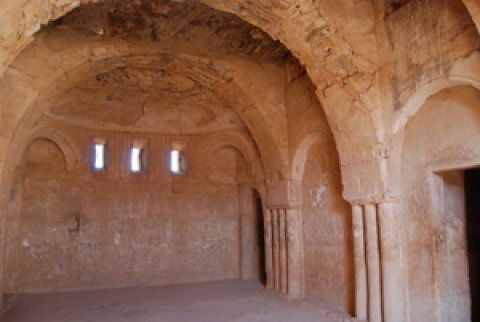Scattered throughout the black basalt desert, east of Amman, the Desert Castles stand as a testament to the flourishing beginnings of Islamic-Arab civilization. These seemingly isolated pavilions, caravan stations, secluded baths, and hunting lodges, were at one time integrated agricultural or trading complexes, built mostly under the Umayyads (661-750 AD), when Muslim Arabs had succeeded in transforming the fringes of the desert into well-watered settlements.
Aside from being widely considered as the most spectacular and original monuments of early Islamic art, these complexes also served practical purposes: namely, as residences, caravanserais, and baths.
In the year 661, the capital of the newly founded Arab Muslim Empire moved from Medina and Kufa in the Hejaz and Iraq respectively, to Damascus, the seat of the Umayyad Dynasty. The years which immediately followed the death of the founder of the dynasty, Mu'awiya bin Abi Sufyan, were spent in overcoming rival claimants to the Caliphate.
The latter part of the reign of AbdulMalek bin Marwan (685-750) seems to have been an exceptionally favorable interlude for the Umayyads. Being more firmly on the saddle, one can detect a sudden release of talent and creativity, which was manifested by the construction of the first major Islamic monument in Jerusalem, the majestic Dome of the Rock. The architectural program initiated by Caliph AbdulMalek, was continued and expanded by his son, Al-Walid, who built the great mosques of Damascus, Jerusalem, and Medina.
Throughout the following decades, the Umayyads dotted the Jordanian steppe with luxurious buildings decorated with splendid mosaic pavements, fresco paintings, and carved stucco. All these indicate that the Umayyads had found a modus vivendi with the Syrian civilization. The fact that several of these buildings were located in the Jordanian steppe points to the overriding importance of the area.
Indeed, the area's incorporation into the military district (Jund) of Damascus, whose governor was directly responsible to Damascus, attests to its vitality.
The Umayyad Desert Castles were initially regarded as desert retreats (Badiyas) for Umayyad princes who, being of nomadic origins, grew weary of city life with all its rigors and congested atmosphere. Those castles allowed them to return to the desert, where their nomadic instincts could be best expressed, and where they could pursue their pastimes away from watchful eyes of the pious minded.
This theory, however, was challenged by the French scholar, Jean Sauvaget. These buildings were located on extensive and elaborately irrigated farmlands, which were often accompanied by various hydraulic structures, and therefore, he argued, they were centers for agricultural exploitation. This was reflected by the Umayyad policy to expand the agricultural zone into marginal areas. Yet another and more recent explanation for the raison d'?tre of these buildings is what might be called the "Architecture of Diplomacy". That is, maintaining close contacts with the tribes of the region who were vehement supporters of the Umayyads.
It is also possible that some of these structures, like Qusayr Amra, Kharaneh and Mshash, served as resting places for high government officials on their way to Hejaz. This restricted and temporary use of these buildings may explain the scarcity of pottery shards from those sites. A combination of factors and coordinates therefore might have been involved in the construction of the Umayyad Desert Castles, and no single element is sufficient to explain them all.
Today, these lonely and evocative structures can be visited in a one-day trip from Amman, as modern paved roads have replaced the ancient desert tracks.



